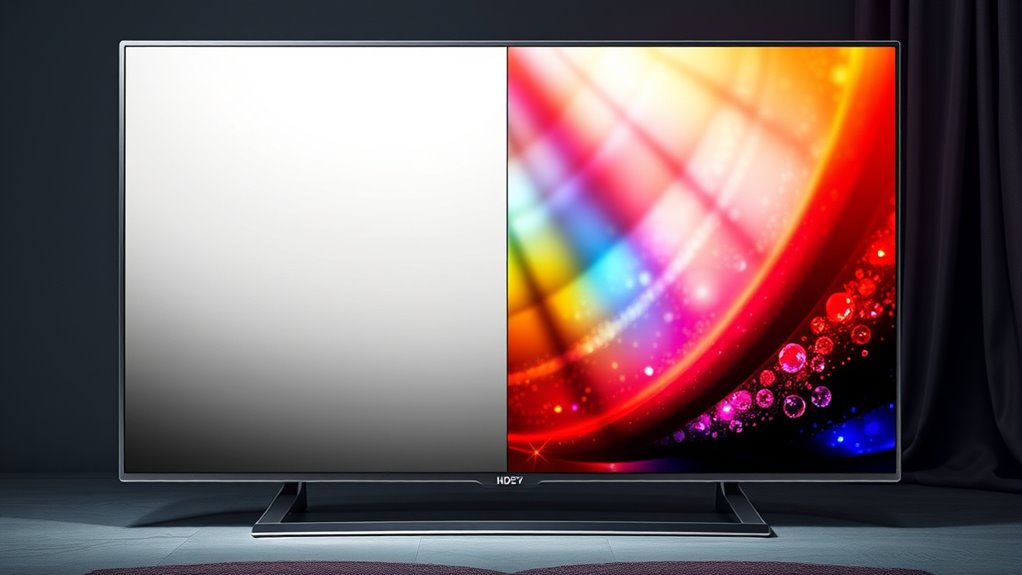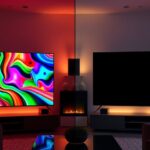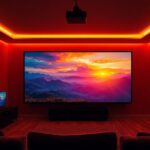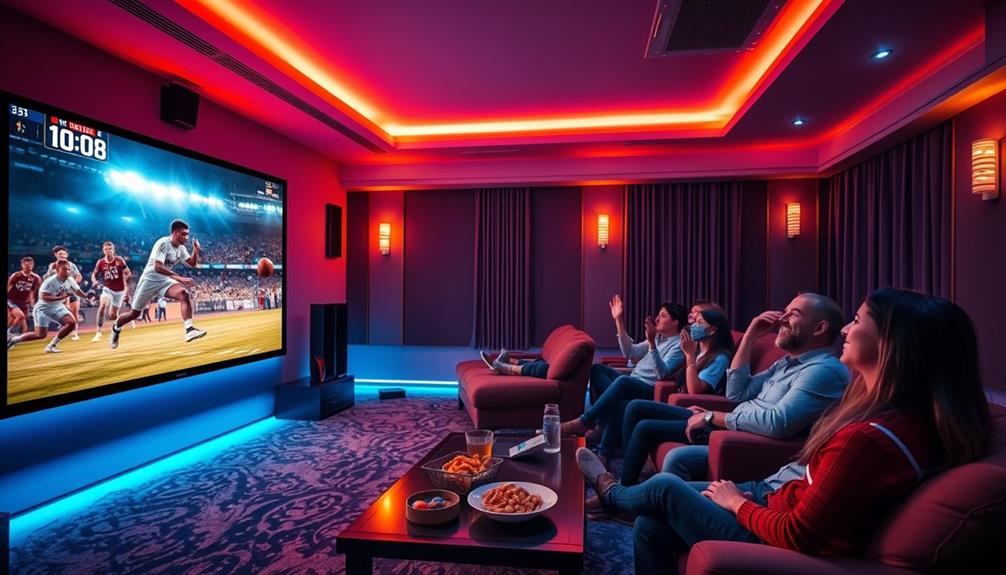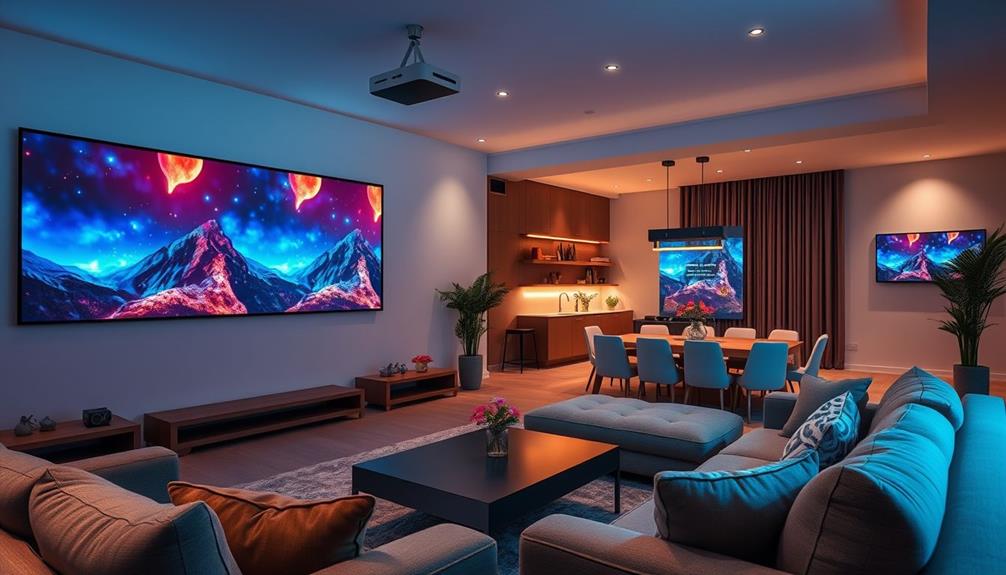HDR10 Plus and Dolby Vision are both dynamic HDR formats that improve picture quality scene by scene, but they differ in key ways. Dolby Vision offers higher color depth, peak brightness, and more precise control, creating more vibrant and lifelike images—but it requires compatible hardware and licensing. HDR10 Plus, being open and royalty-free, is easier to adopt across devices. Understanding these differences can help you choose the best format; if you explore further, you’ll uncover even more distinction.
Key Takeaways
- Dolby Vision supports up to 12 bits of color depth and higher peak brightness, offering more vibrant and detailed images than HDR10 Plus.
- HDR10 Plus is an open, royalty-free standard, making it more widely accessible across devices, while Dolby Vision requires licensing and proprietary hardware.
- Dolby Vision provides more precise scene-by-scene or frame-by-frame optimization due to its advanced dynamic metadata capabilities.
- Both formats enhance HDR content, but Dolby Vision generally delivers a more immersive, lifelike viewing experience with richer colors and contrast.
- Device and content support influence real-world quality, with Dolby Vision often offering a slight performance edge in visual fidelity.

When choosing between HDR10 Plus and Dolby Vision, understanding their differences can substantially enhance your viewing experience. Both formats aim to deliver richer colors, deeper contrast, and more detail in dark and bright scenes, but they do so through different approaches. HDR10 Plus is an open standard developed by Samsung and Amazon, allowing content creators to include dynamic metadata that adjusts picture settings scene by scene or even frame by frame. This means each part of a movie or show can be optimized for the best possible picture quality without requiring a proprietary license. Dolby Vision, on the other hand, is a proprietary format from Dolby Laboratories. It also uses dynamic metadata, but it often offers more precise control over brightness, contrast, and color at a scene-specific level, thanks to its higher maximum luminance and bit depth.
You’ll find that Dolby Vision generally supports up to 12 bits of color depth, compared to HDR10 Plus’s 10 bits. This means Dolby Vision can display a broader range of colors and more subtle gradations, resulting in smoother gradients and more realistic images. Additionally, Dolby Vision’s higher peak brightness capability allows highlights to pop more vividly, creating a more striking visual impact. Because Dolby Vision is a closed system, it requires compatible hardware and licensing fees, which can sometimes influence device choices and content availability. HDR10 Plus, being open and royalty-free, tends to be more widely adopted across various devices and streaming platforms, but it may not always match Dolby Vision’s peak performance in terms of luminance and color depth.
Your viewing experience will vary depending on the content and device support. If you have a Dolby Vision-supported TV or streaming device, you’ll notice more vibrant colors, better contrast, and more nuanced details in high-dynamic-range scenes. With HDR10 Plus, you’ll still enjoy significant improvements over standard HDR, but the overall picture quality might not be as refined or consistent. Content compatibility is another consideration; many streaming services and UHD Blu-rays now support both formats, but some may favor Dolby Vision due to its premium standards. Ultimately, your choice might depend on your hardware, your content library, and your desire for the highest possible picture quality. Both formats aim to elevate your viewing experience, but Dolby Vision’s advanced capabilities tend to offer a slight edge in delivering the most immersive, lifelike images.
Frequently Asked Questions
Do HDR10 Plus and Dolby Vision Require Different Hardware?
You might wonder if HDR10 Plus and Dolby Vision need different hardware. The answer is yes; each format requires compatible hardware to work properly. Your TV or monitor must support either HDR10 Plus or Dolby Vision to enjoy their benefits. Some devices support both, but check your device specs before purchasing. So, verify your hardware is compatible with the specific HDR format you want to use for the best viewing experience.
Can I Use HDR10 Plus and Dolby Vision on the Same Device?
A stitch in time saves nine, so check your device’s specs first. You can use HDR10 Plus and Dolby Vision on the same device if it’s compatible with both formats. Many newer TVs and streaming devices support both, but older models might not. Always verify your device’s capabilities to enjoy the best HDR experience without hassle. Compatibility varies, so don’t assume—you need the right hardware to switch seamlessly between these formats.
Is One Format More Future-Proof Than the Other?
You wonder if one HDR format is more future-proof. While Dolby Vision offers broader support and more advanced features, HDR10 Plus is gaining traction with manufacturers and content creators. If you want a format with more widespread adoption and ongoing support, Dolby Vision might be the safer bet. However, both formats are evolving, so staying flexible with compatible devices guarantees you’ll enjoy the latest HDR experiences no matter which format dominates later.
How Do HDR10 Plus and Dolby Vision Impact Streaming Quality?
HDR10 Plus and Dolby Vision enhance streaming quality by delivering brighter highlights, deeper blacks, and richer colors. You’ll notice more detail and realism in your favorite content, especially in darker scenes. Dolby Vision often offers better optimization with dynamic metadata, ensuring each shot looks its best. Both formats improve your viewing experience, but Dolby Vision generally provides a more consistently stunning picture, especially on compatible high-end devices.
Are There Any Content Limitations for HDR10 Plus and Dolby Vision?
Did you know that about 70% of new streaming content now supports HDR formats? When it comes to limitations, HDR10 Plus and Dolby Vision don’t restrict content creation but do require compatible devices. You might find some older TVs or devices don’t support these formats, limiting your viewing options. Overall, both formats are increasingly adopted, but check your device compatibility to enjoy the full benefits without restrictions.
Conclusion
Ultimately, whether you choose HDR10 Plus or Dolby Vision depends on what you prioritize in your viewing experience. Both formats aim to deliver stunning visuals, but their differences might align with your preferences—like Dolby Vision’s broader support or HDR10 Plus’s dynamic tone mapping. Sometimes, it feels like the universe nudges you toward one or the other, making the decision almost effortless. Whichever you pick, you’re bound to enjoy a richer, more vibrant picture—it’s almost as if technology is guiding you there.
